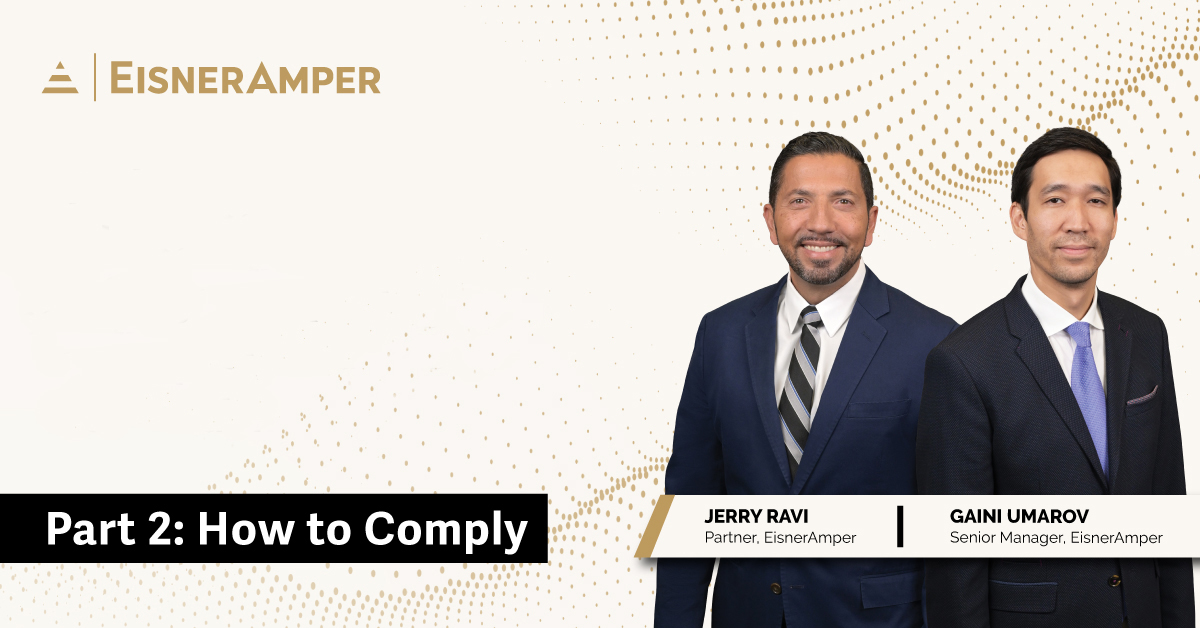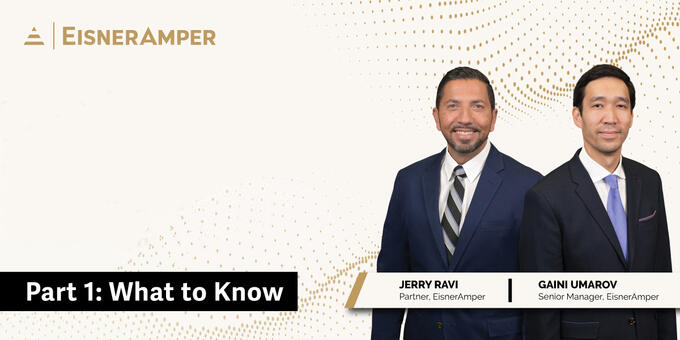
Enhancing Risk Management with Process Automation
- Published
- Dec 17, 2020
- Share
In this final podcast of Process Risk and Technology Solutions' series on Risk Management, Nina Kelleher explores ways that robotics process automation (RPA) can be deployed to facilitate an effective Risk Management program.
Transcript
Nina Kelleher: Hello, and welcome to EisnerAmper podcast series on Risk Management. I'm your host Nina Kelleher. And today I'll be speaking with Greg Fritsky. Greg specializes in robotics, process automation, data analytics, and cognitive and artificial intelligence among other areas.
In my prior podcast, I discussed the importance of information technology in relation to risk management. In this podcast, I'd like to continue our risk management discussion, but shift the focus to how risk management can benefit from process automation and data analytics.
I was able to sit down with Greg to get his perspective on data transformation, all that that encompasses. Hi, Greg, can you tell us briefly, what is robotics process automation?
Greg Fritsky: Hi, Nina, I'd be happy to. So, robotics process automation also known as RPA has been around probably for the last 5 to 10 years, probably longer, but really known as RPA more recently. And it's essentially what I call a digital worker.
It's essentially using a software bot to perform the tasks of an individual. So any type of manual, repetitive, redundant, rules-based tasks could actually be executed using software bots. This technology continues to expand and a number of different folks are using it in their organizations.
NK: Thanks, that's helpful. Can you give us some idea how RPA can be used to capture data for risk analytics?
GF: Yes. RPA is, because it's repetitive, because it's able to go across systems, it's able to aggregate data in a very, I wouldn't say simple way, but in a very harmonized way. Meaning it can extract data, bring it into a central source.
It can actually turn unstructured data into structured. It can help prepare Excel spreadsheets that you may be using. And it may actually be able to run some of your macros and some of your extraction tools.
So it's very powerful from a data aggregation standpoint, but it can also be used to run algorithms and programs around data analytics and can provide a lot of information over high volumes of data and transactions, especially in the financial services space.
NK: Can you talk a little bit more about how RPA has helped in the financial services space in particular around analyzing and visualizing their metrics?
GF: Sure. RPA is very useful. Analytics obviously has been in place for financial firms in the front office to help with making trade decisions, but in the middle to back office, all the processing trade compliance, know your client allocations.
All kinds of rules and regulatory issues can be managed with, with RPA. So processes like a trade that gets executed, the deal capture goes through allocations, the different counterparties and brokers.
You may have tolerances set and rules based on where you can actually apply the deal or how you have to break the deal up. A lot of that pre-trade compliance and also post-trade compliance activities can be managed with RPA and help with regulatory and compliance matters.
NK: So what would you say to some of these financial firms that feel like they're too small to deploy some robotics?
GF: That's often a concern, is how big is not necessarily a challenge. I would say that the challenge more or less is the use cases that you have. So if you're in the transaction processing business, trades transactions, high volumes, you're going to find a lot of opportunities to achieve efficiencies and use it for regulatory compliance purposes.
So what I would say to those companies that think they're too small is understanding what your return on investment is, what the value is you're to achieve. So, regardless of what the cost is, if it's going to cost me X to implement, and I'm going to get 3X, 5X, 10X of the value, then it speaks to itself. So it really doesn't come down to size of the company or the spend. It's really the value you're going to achieve.
NK:That's great insight. What's some advice that you can give to financial services firms to continue to get more out of their technology?
GF: Financial service firms are always at the cutting edge of technology, but they're always looking for more. I would say, looking for opportunities to integrate data and systems is always a challenge. You get greater insights if you're able to combine your accounting, operation systems, trading systems. Trying to find some common taxonomy across the organization so that you're able to identify where your source data's coming from and make sense of it.
So data integration is key, and RPA can certainly help with that. The other area, and we're seeing more traction, is around the unstructured data. Information you may be harvesting from outside of the organization. That's, possibly it's unstructured, or it's out on social media or there's other types of factors you're implementing or considering.
RPA can help with that and manage that. So I would say to financial organizations, as they continue lead, to look at opportunities with data outside their organizations and how RPA can be part of the program to help them manage large quantities of data.
NK:Thanks Greg, would you be able to give our listeners some ideas of best practices that you've seen or help companies use to deploy FinTech as it relates to risk management?
GF: Happy to. What I oftentimes see is that companies are looking for ways to expand beyond the initial proof of value. So they do, once you've got your arms around what the technology can do, putting a program in place is important with a clear direction and project plan.
But beyond that, I often emphasize setting up a center of expertise, which would be a combination of folks who know the business, possibly folks from finance or trading. People from risk management and auditing. And also obviously it and data analytics folks.
Putting together a consortium of specialists in these different areas helps build these programs, governance model, and also helps you steward the data better. So, these programs, these continuous improvement programs are being put in place by companies both large and small.
It doesn't have to be all the people I said, but oftentimes it's really just having different people at the table as you define the program and figure out how you can deploy these technologies.
NK:Greg, thank you for this valuable information and thank you for listening to the EisnerAmper podcast series. For more information on this and a host of other topics, visit eisneramper.com/prts, and join us for our next podcast.
Also Available On
What's on Your Mind?
Start a conversation with Nina
Receive the latest business insights, analysis, and perspectives from EisnerAmper professionals.











